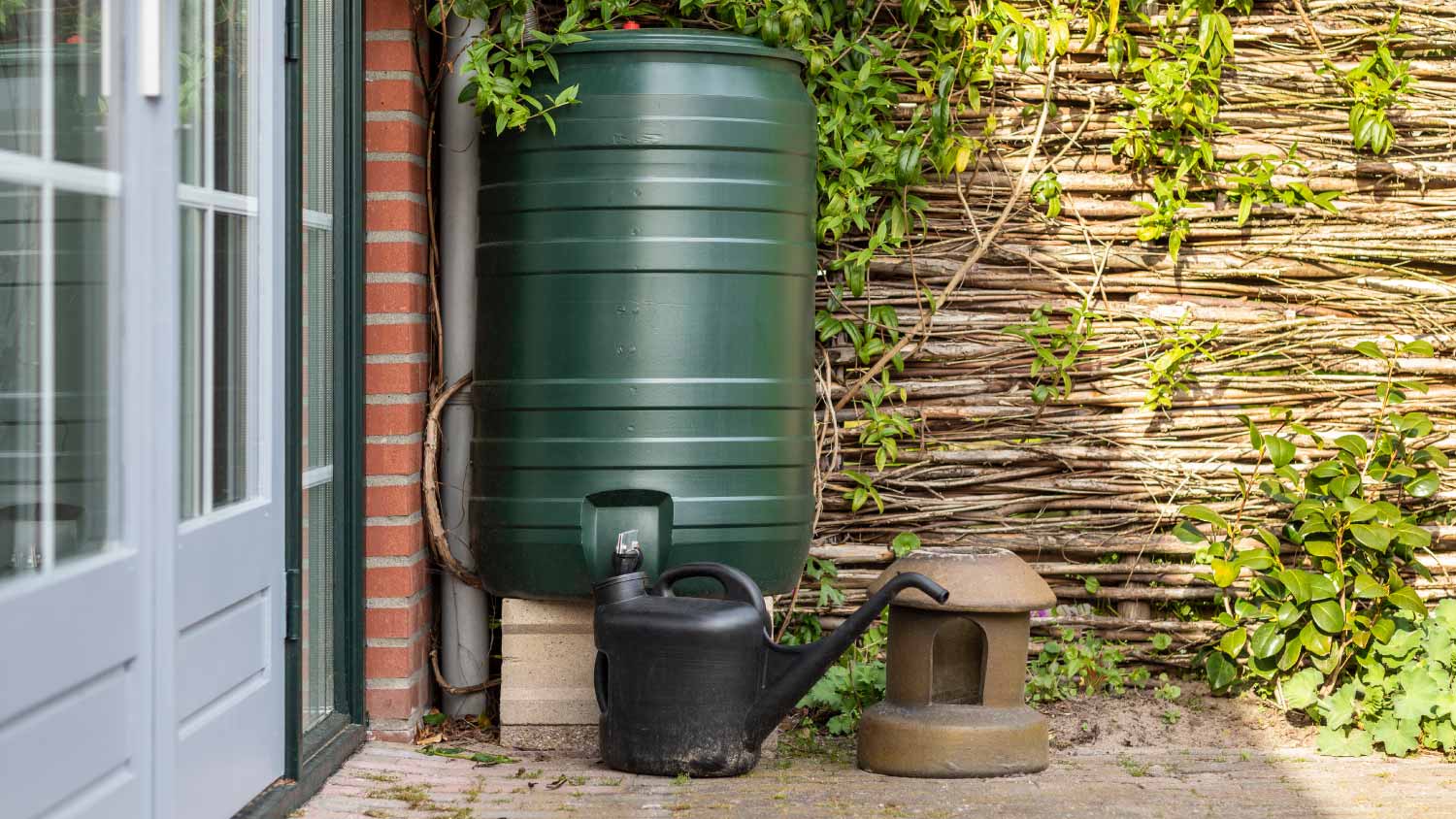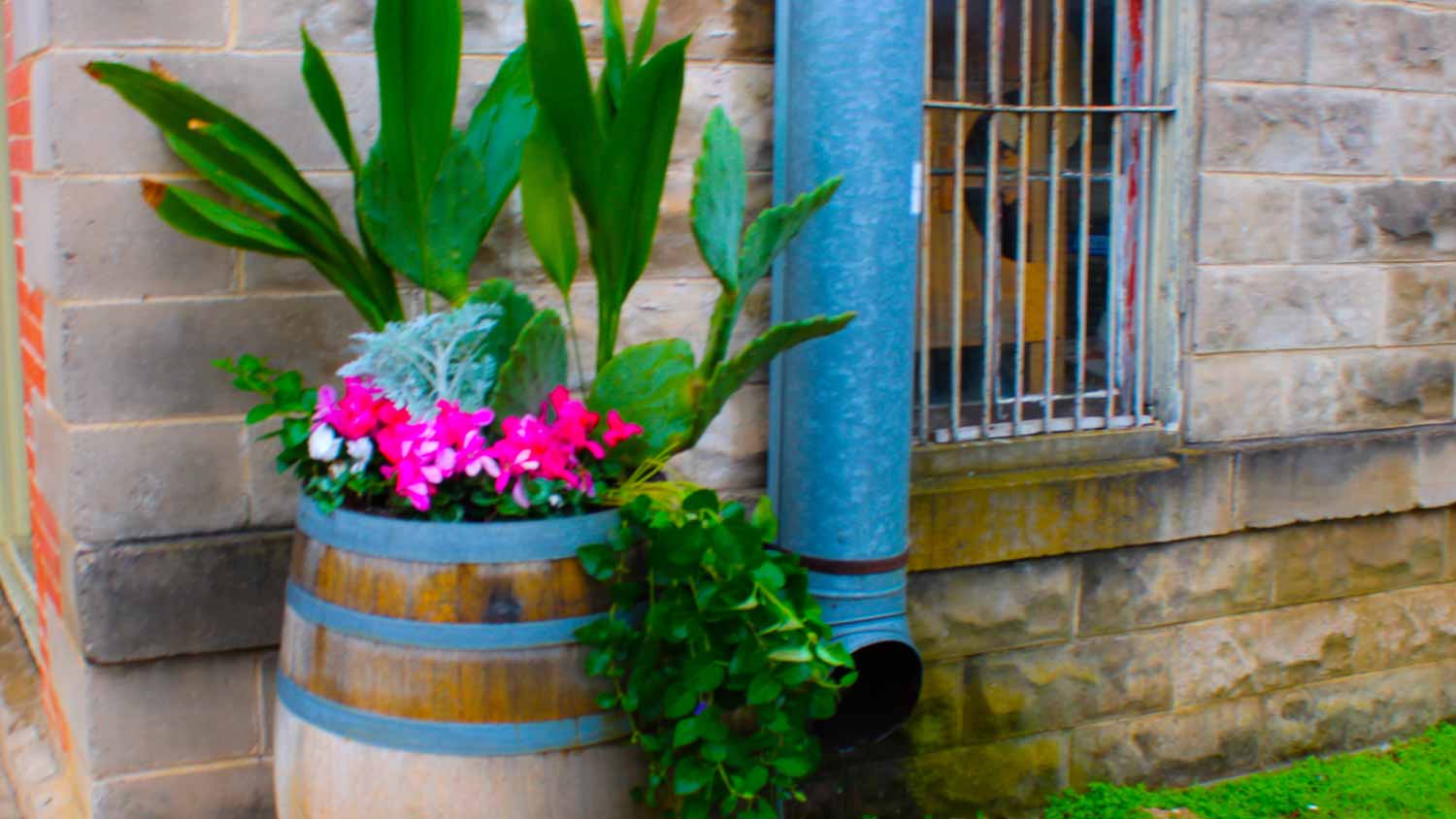
Heated gutters are a great way to minimize gutter damage and maintenance. Use this guide to estimate your heated gutter cost before getting started.
Make collecting rainwater a barrel of eco-friendly fun with this guide


Rain barrels collect rainwater that can be repurposed for watering gardens.
Most people consider wooden oak barrels to be the aesthetic standard.
Plastic options are affordable and easy to clean.
Barrels of all types range in price from $20–$200.
Rain barrels are eco-friendly, satisfying additions to your home that allow you to catch rain that can be repurposed for watering a garden. This guide to different types of rain barrels will help you make the right choice when selecting a decorative or gutter rain barrel for your home.
There’s a wide variety of rain barrels on the market, ranging from purely practical to aesthetically whimsical. The best fit for your home may come down to what you plan to use your rainwater for once it's collected.


A plastic rain barrel is essentially a large plastic drum. The advantage to plastic is that it's easy to clean and care for with limited worry about mold or rot forming on the barrel's interior or exterior surfaces. Most standard plastic rain barrels for home use are between 50 and 55 gallons. That means they can store around 870 pounds of liquid. However, some petite varieties start at 30 gallons.
The barrel design is convenient because it features two openings. While one opening is used to pour water, the other is a vent that ensures the rainwater that is collected can "breathe." A high-quality plastic rain barrel typically ranges in price from $130 to $200.
Plastic rain barrels come with pros and cons. While the lightweight nature of plastic is nice when you need to move your barrel, these barrels can be knocked over easily by heavy winds when they aren't full. Plastic barrels are also less aesthetically pleasing compared to something like a wooden rain barrel. They can fade in the sun and have no way to be refinished.
Of course, the lower price and long lifespan of a plastic rain barrel make it a great choice for many people. Plastic barrels are also much easier to drain and store in the winter compared to other options.

A real wooden rain barrel brings a rustic look to your property. Wooden barrels are more substantial compared to plastic barrels and are much less likely to get knocked over by high winds. They can also be restained to ensure a gorgeous finish year after year.
Wooden rain barrels generally tend to hold more water than plastic barrels. Most hold 60 gallons.
Of course, wooden barrels require more maintenance compared to plastic barrels. They generally need wood preservation treatments every three to seven years. And wooden barrels typically don't come with the built-in spout holes that are standard on plastic barrels (custom carpentry may be required if you want to add them). Your barrel may also need blocks or bricks for support.
You may need to use mosquito control methods with this type of barrel. Products called mosquito "dunks" that look like little donuts are often used to treat standing water kept in wooden containers.
Finally, wooden barrels can be more expensive than other options. Most start at around $200.
Also known as collapsible rain barrels, pop-up barrels are made of a flexible, puncture-resistant type of vinyl or polyester. These barrels can be folded flat when they're not being used. Most can hold between 30 and 50 gallons. They also come with built-in nozzles.
A pop-up barrel can be a cheap alternative to a more traditional rain barrel if you aren't concerned with aesthetics. Most cost between $20 and $30. Keep in mind that this option is not very resistant to high winds.

Available in barrel styles, box styles, and vase-like silhouettes, rain-collecting planters are decorative and practical options for collecting rainwater. They work very similarly to traditional plastic rain barrels with built-in spigots, but they also have planters on top where you can plant flowers or herbs or simply store gardening tools. Most are made from a high-grade polyethylene that requires essentially no maintenance.
Planter-style rain barrels can usually hold up to 50 gallons of water. Most cost between $150 and $170.
Choosing between different types of rain barrels comes down to your budget, aesthetics, and the amount of time you’re willing to devote to upkeep. If you don't need to stick to a specific budget, pop-up rain barrels should generally be at the bottom of the list due to their low aesthetic appeal and lightweight nature. If you're willing to put in the time to handle maintenance, a wooden rain barrel offers a traditional, high-end look. Both standard plastic rain barrels and planter-style plastic barrels are great options if you want an easy, hassle-free way to collect rainwater that still looks pretty good.
Adding a rain barrel to your home is as easy as picking out a style you like. But if you're specifically planning to use your new barrel as a gutter rain barrel, things can get a little more complicated. A local gutter installer can help you to choose the right placement to ensure that your new barrel is collecting water as intended. Different types of gutters may require slight tweaks to ensure that the flow is right for collection. You may also need to consider extending gutter downspouts to reach your barrels.
Homeowners schedule gutter cleaning and maintenance for many reasons, and it plays an important role in keeping rain barrels working effectively. Based on responses from 72,300 Angi customers, the most common reason for cleaning, reported by 33% of homeowners, is regular maintenance, while 30% request service due to clogged gutters. Since clogs can stop water from flowing into rain barrels, routine gutter care is essential not only for protecting the home but also for ensuring rain barrels can collect water properly.
From average costs to expert advice, get all the answers you need to get your job done.

Heated gutters are a great way to minimize gutter damage and maintenance. Use this guide to estimate your heated gutter cost before getting started.

Installing copper gutters adds beauty and value to your home. The cost of your project will depend on the size of your home, the size of your gutters, and the thickness of the material.

Gutter repair costs may not be as high as you think—but it depends on the type of damage you're addressing. Learn why you need to hire a gutter pro for this work.

Are you planning on installing gutters on your home? Before you get started, be prepared to discuss these gutter installation questions with your contractor.

This guide explains the cost to install underground gutter drainage on your property. The cost may seem high but learn how the number is reached.

Common gutter alternatives include rain chains, French drains, drip edges, and rain dispersal systems. Keep reading to see which gutter alternative is best.